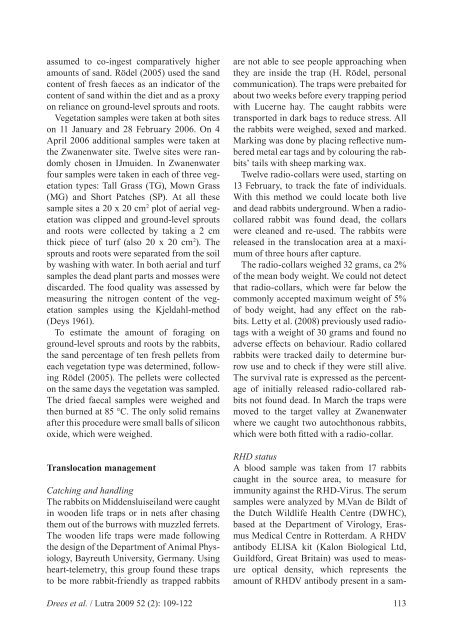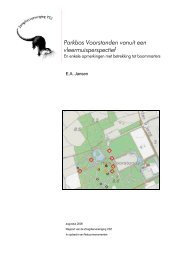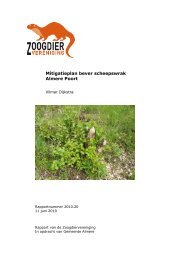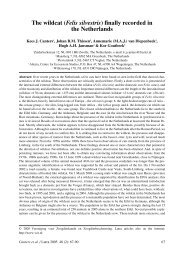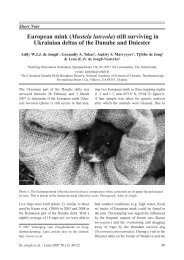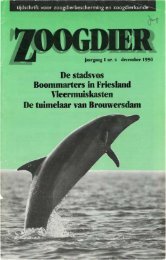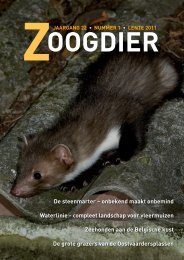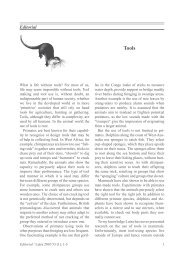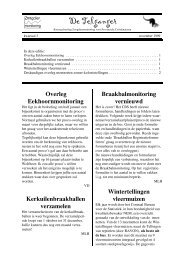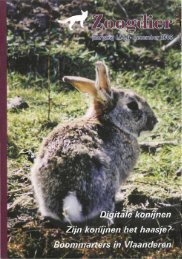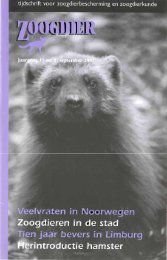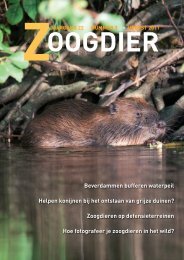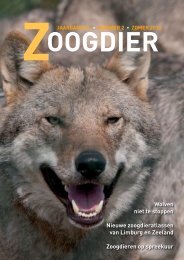The translocation of rabbits in a sand dune habitat - De ...
The translocation of rabbits in a sand dune habitat - De ...
The translocation of rabbits in a sand dune habitat - De ...
You also want an ePaper? Increase the reach of your titles
YUMPU automatically turns print PDFs into web optimized ePapers that Google loves.
assumed to co-<strong>in</strong>gest comparatively higheramounts <strong>of</strong> <strong>sand</strong>. Rödel (2005) used the <strong>sand</strong>content <strong>of</strong> fresh faeces as an <strong>in</strong>dicator <strong>of</strong> thecontent <strong>of</strong> <strong>sand</strong> with<strong>in</strong> the diet and as a proxyon reliance on ground-level sprouts and roots.Vegetation samples were taken at both siteson 11 January and 28 February 2006. On 4April 2006 additional samples were taken atthe Zwanenwater site. Twelve sites were randomlychosen <strong>in</strong> IJmuiden. In Zwanenwaterfour samples were taken <strong>in</strong> each <strong>of</strong> three vegetationtypes: Tall Grass (TG), Mown Grass(MG) and Short Patches (SP). At all thesesample sites a 20 x 20 cm 2 plot <strong>of</strong> aerial vegetationwas clipped and ground-level sprout<strong>sand</strong> roots were collected by tak<strong>in</strong>g a 2 cmthick piece <strong>of</strong> turf (also 20 x 20 cm 2 ). <strong>The</strong>sprouts and roots were separated from the soilby wash<strong>in</strong>g with water. In both aerial and turfsamples the dead plant parts and mosses werediscarded. <strong>The</strong> food quality was assessed bymeasur<strong>in</strong>g the nitrogen content <strong>of</strong> the vegetationsamples us<strong>in</strong>g the Kjeldahl-method(<strong>De</strong>ys 1961).To estimate the amount <strong>of</strong> forag<strong>in</strong>g onground-level sprouts and roots by the <strong>rabbits</strong>,the <strong>sand</strong> percentage <strong>of</strong> ten fresh pellets fromeach vegetation type was determ<strong>in</strong>ed, follow<strong>in</strong>gRödel (2005). <strong>The</strong> pellets were collectedon the same days the vegetation was sampled.<strong>The</strong> dried faecal samples were weighed andthen burned at 85 °C. <strong>The</strong> only solid rema<strong>in</strong>safter this procedure were small balls <strong>of</strong> siliconoxide, which were weighed.Translocation managementCatch<strong>in</strong>g and handl<strong>in</strong>g<strong>The</strong> <strong>rabbits</strong> on Middensluiseiland were caught<strong>in</strong> wooden life traps or <strong>in</strong> nets after chas<strong>in</strong>gthem out <strong>of</strong> the burrows with muzzled ferrets.<strong>The</strong> wooden life traps were made follow<strong>in</strong>gthe design <strong>of</strong> the <strong>De</strong>partment <strong>of</strong> Animal Physiology,Bayreuth University, Germany. Us<strong>in</strong>gheart-telemetry, this group found these trapsto be more rabbit-friendly as trapped <strong>rabbits</strong>are not able to see people approach<strong>in</strong>g whenthey are <strong>in</strong>side the trap (H. Rödel, personalcommunication). <strong>The</strong> traps were prebaited forabout two weeks before every trapp<strong>in</strong>g periodwith Lucerne hay. <strong>The</strong> caught <strong>rabbits</strong> weretransported <strong>in</strong> dark bags to reduce stress. Allthe <strong>rabbits</strong> were weighed, sexed and marked.Mark<strong>in</strong>g was done by plac<strong>in</strong>g reflective numberedmetal ear tags and by colour<strong>in</strong>g the <strong>rabbits</strong>’tails with sheep mark<strong>in</strong>g wax.Twelve radio-collars were used, start<strong>in</strong>g on13 February, to track the fate <strong>of</strong> <strong>in</strong>dividuals.With this method we could locate both liveand dead <strong>rabbits</strong> underground. When a radiocollaredrabbit was found dead, the collarswere cleaned and re-used. <strong>The</strong> <strong>rabbits</strong> werereleased <strong>in</strong> the <strong>translocation</strong> area at a maximum<strong>of</strong> three hours after capture.<strong>The</strong> radio-collars weighed 32 grams, ca 2%<strong>of</strong> the mean body weight. We could not detectthat radio-collars, which were far below thecommonly accepted maximum weight <strong>of</strong> 5%<strong>of</strong> body weight, had any effect on the <strong>rabbits</strong>.Letty et al. (2008) previously used radiotagswith a weight <strong>of</strong> 30 grams and found noadverse effects on behaviour. Radio collared<strong>rabbits</strong> were tracked daily to determ<strong>in</strong>e burrowuse and to check if they were still alive.<strong>The</strong> survival rate is expressed as the percentage<strong>of</strong> <strong>in</strong>itially released radio-collared <strong>rabbits</strong>not found dead. In March the traps weremoved to the target valley at Zwanenwaterwhere we caught two autochthonous <strong>rabbits</strong>,which were both fitted with a radio-collar.RHD statusA blood sample was taken from 17 <strong>rabbits</strong>caught <strong>in</strong> the source area, to measure forimmunity aga<strong>in</strong>st the RHD-Virus. <strong>The</strong> serumsamples were analyzed by M.Van de Bildt <strong>of</strong>the Dutch Wildlife Health Centre (DWHC),based at the <strong>De</strong>partment <strong>of</strong> Virology, ErasmusMedical Centre <strong>in</strong> Rotterdam. A RHDVantibody ELISA kit (Kalon Biological Ltd,Guildford, Great Brita<strong>in</strong>) was used to measureoptical density, which represents theamount <strong>of</strong> RHDV antibody present <strong>in</strong> a sam-Drees et al. / Lutra 2009 52 (2): 109-122 113


